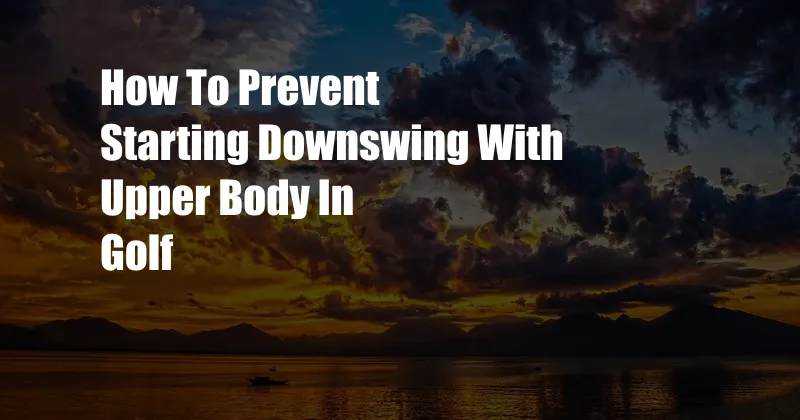
How to Prevent Starting Downswing with Upper Body in Golf
Mastering the Perfect Downswing Initiation in Golf
The golf swing is a complex motion that requires excellent timing, coordination, and technique. Among its crucial elements is the downswing, where the golfer transitions from the backswing into the impact zone. A common error that golfers make during the downswing is starting it with the upper body, leading to inconsistencies and a loss of power. This guide will delve into the reasons behind this error and provide detailed instructions on how to initiate the downswing correctly, focusing on the lower body’s pivotal role.
Understanding the downswing’s mechanics is crucial. The golfer’s weight should shift from the back foot to the front foot while simultaneously rotating the hips and shoulders. However, when the upper body initiates the downswing prematurely, the golfer loses balance and timing. The clubhead drops too steeply, resulting in a loss of control and distance.
The Importance of Leading with the Lower Body
In a proper golf swing, the downswing should be initiated by the lower body, primarily the hips and legs. This creates a solid foundation and provides the power to drive the club through impact. Starting the downswing with the hips allows the golfer to generate speed and control the clubhead throughout the swing.
By leading with the lower body, the golfer can effectively transfer weight from the back foot to the front foot and initiate the hip rotation. This sequence ensures that the upper body follows the lower body in a coordinated and powerful motion.
Detailed Instructions for Initiating Downswing with Lower Body
- Shift Weight to Back Foot: During the backswing, the majority of weight should rest on the back foot.
- Initiate Hip Rotation: As the backswing reaches its peak, begin rotating the hips towards the target.
- Transfer Weight to Front Foot: Simultaneously, transfer weight to the front foot as the hips rotate.
- Keep Upper Body Stable: As the hips rotate, maintain a stable upper body position. Allow the arms and club to follow the natural motion of the lower body.
- Extend Arms Towards Target: As the hips rotate through impact, extend the arms towards the target, ensuring the clubhead follows a straight path.
Common Mistakes and Solutions
Problem: Excessive Upper Body Movement: This can occur if the golfer attempts to start the downswing with the shoulders or arms. Solution: Focus on rotating the hips first, keeping the upper body relaxed and following the lower body’s motion.
Problem: Swaying Towards the Target: Shifting weight too quickly towards the target can lead to a swaying motion. Solution: Maintain balance by transferring weight gradually from the back foot to the front foot.
Problem: Casting the Club: Trying to generate power with the arms and hands can lead to “casting” the club. Solution: Allow the momentum generated by the lower body to drive the club through impact.
Conclusion
Initiating the downswing with the upper body is a common error that can hinder a golfer’s progress. By focusing on leading with the lower body, golfers can establish a solid foundation for the downswing, generate power, and improve their overall swing technique. This comprehensive guide provides detailed instructions and troubleshooting tips to help golfers master the correct downswing initiation and enhance their performance on the golf course.
Are you ready to improve your golf game by mastering the art of initiating the downswing with your lower body? Leave a comment below and let’s continue the conversation!